Flower Shapes: Terminology
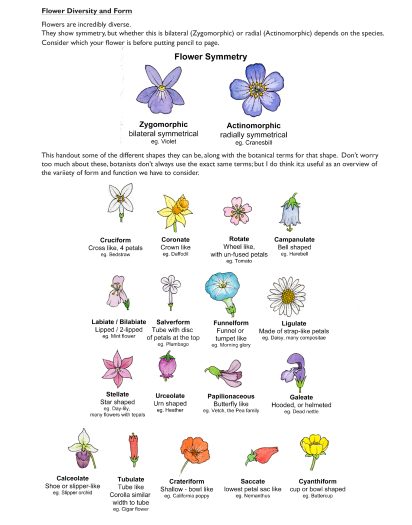
There are a whole load of different botanical terms used to describe flower shapes. In this blog, I’ll go through a few, explaining what the term means. Ill try to find one of my botanical illustrations to demonstrate each shape. Could be a challenge!
This chart of flowers of walks and the wayside shows a wide variety of different flower shapes. Here’s how we go about naming some of them…
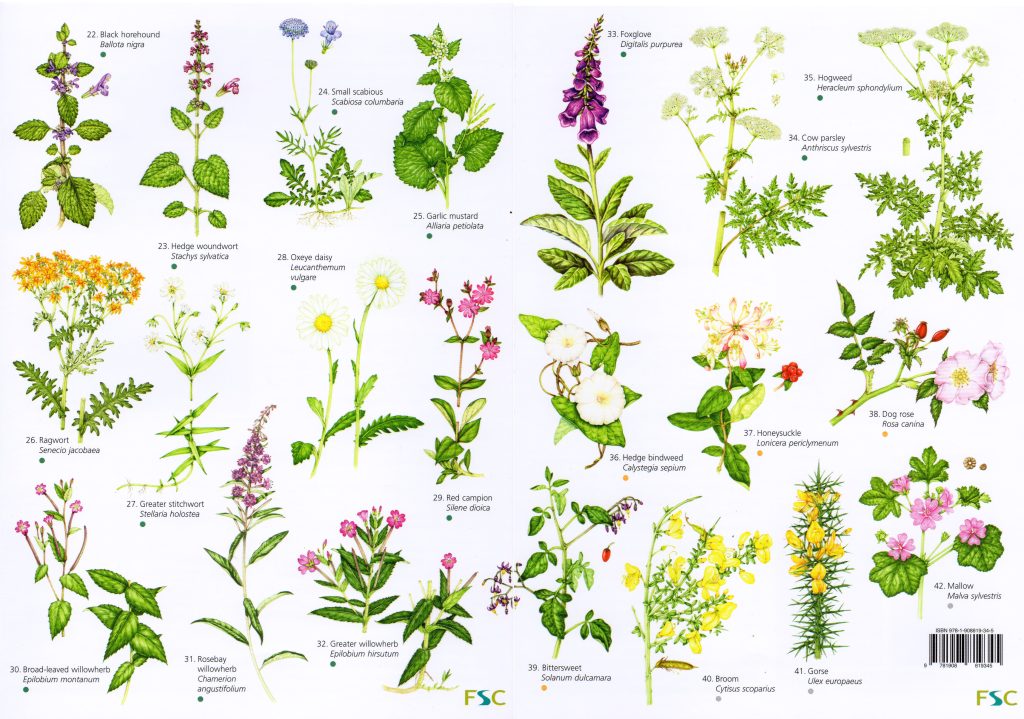
First, we have to accept the amazing variety of form. So what causes this variety? Flower shape depends on how the segments of the perianth (sepals and petals) are arranged, and what shape they are.
I need to give a caveat before setting out. There is an enormous amount of variation between definitions of flower shape. Different botanists use different terms. They may choose from only a handful of shape definitions, or from an enormous selection. Many of the definitions seem to be almost inter-changeable. I’ve done my best to try and untangle some of these contradictions, but please do get in touch in the comments section if you spot glaring errors!
Flower symmetry
The first thing to consider is the axis of symmetry. Does the flower have bilateral symmetry? Does it have a clear top and bottom, with two similar sides? If you cut it in half would both sides be mirror images? This is known as Zygomorphic symmetry. Violets show this form.
If a flower is radially symmetrical, then you can cut it in half anywhere and the halves will be identical. It’s a little like the idea of cutting a cake into two equal parts. This is referred to as being Actinomorphic. Most flowers show this symmetry; cranesbills and daisies, forget-me-nots, roses, and borage flowers.
For more on flower symetry, check out the blog from Orbis Environment.
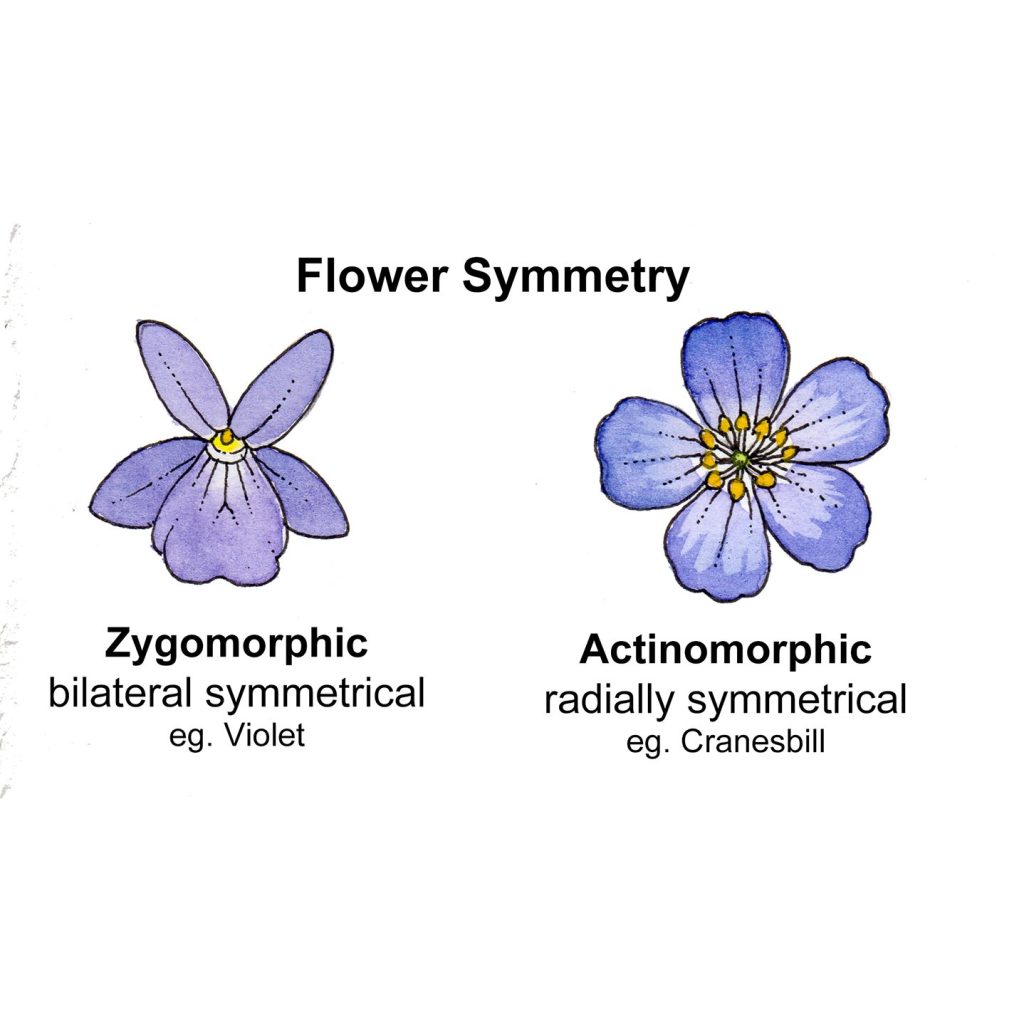
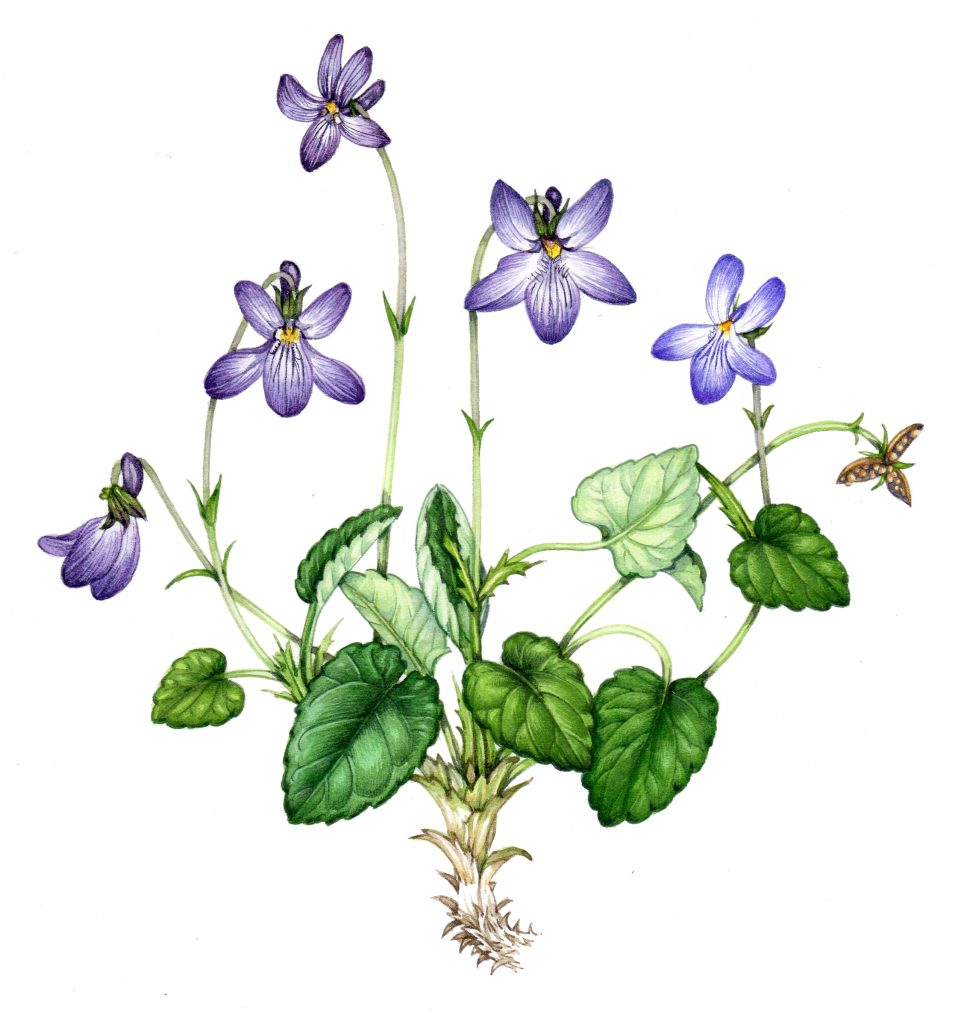
Early dog violet Viola reichenbachiana with several flowers showing Zygomorphic symmetry
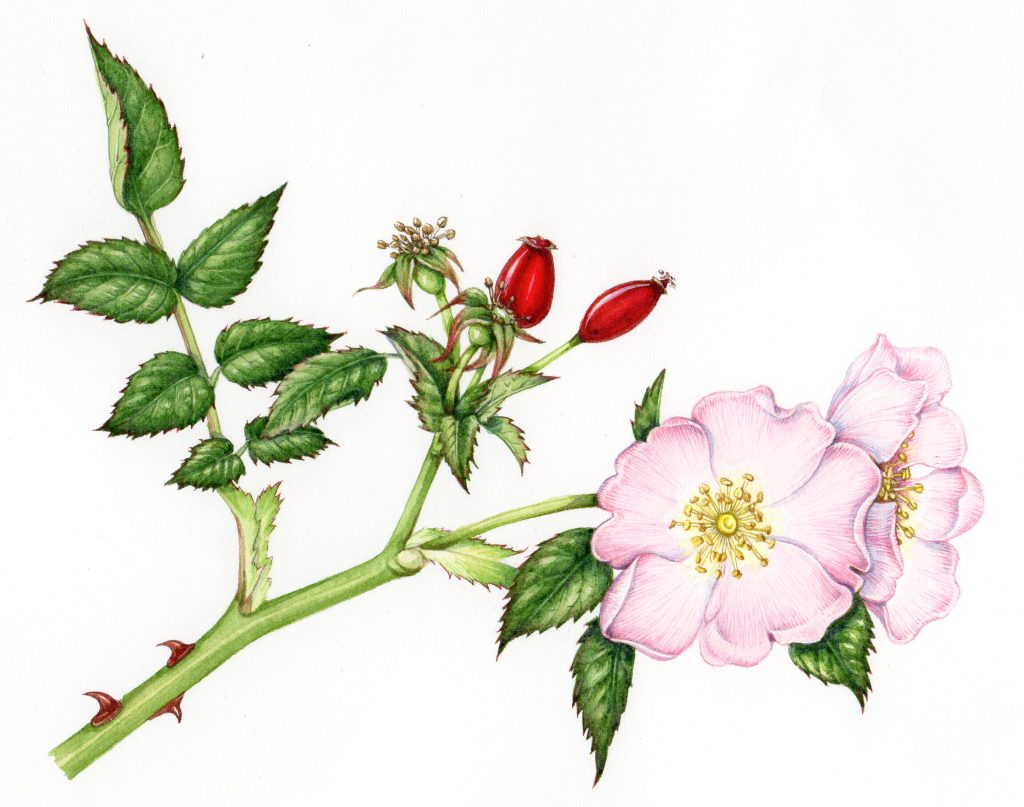
Dog rose Rosa canis showing Actinomorphic symmetry
Flower shapes: How to approach these terms
There’s no pretty way to do this, except by working through each botanical term one by one. Brace yourselves, there are about eighteen of these terms to get through!
Cyanthiform
First up is Cyanthiform. A Cyanthiform flower is shaped like a cup of a bowl. It has radial or actinomorphic symmetry. The petals curve upwards, forming the bowl shape.
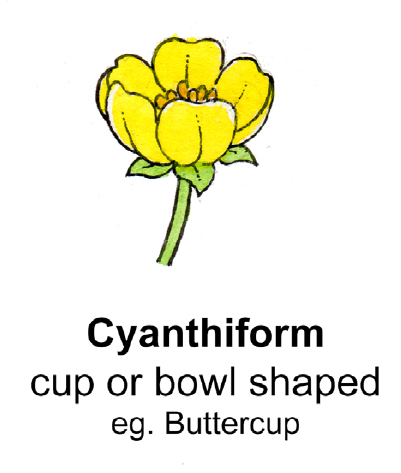
Buttercups have Cyanthiform flowers.
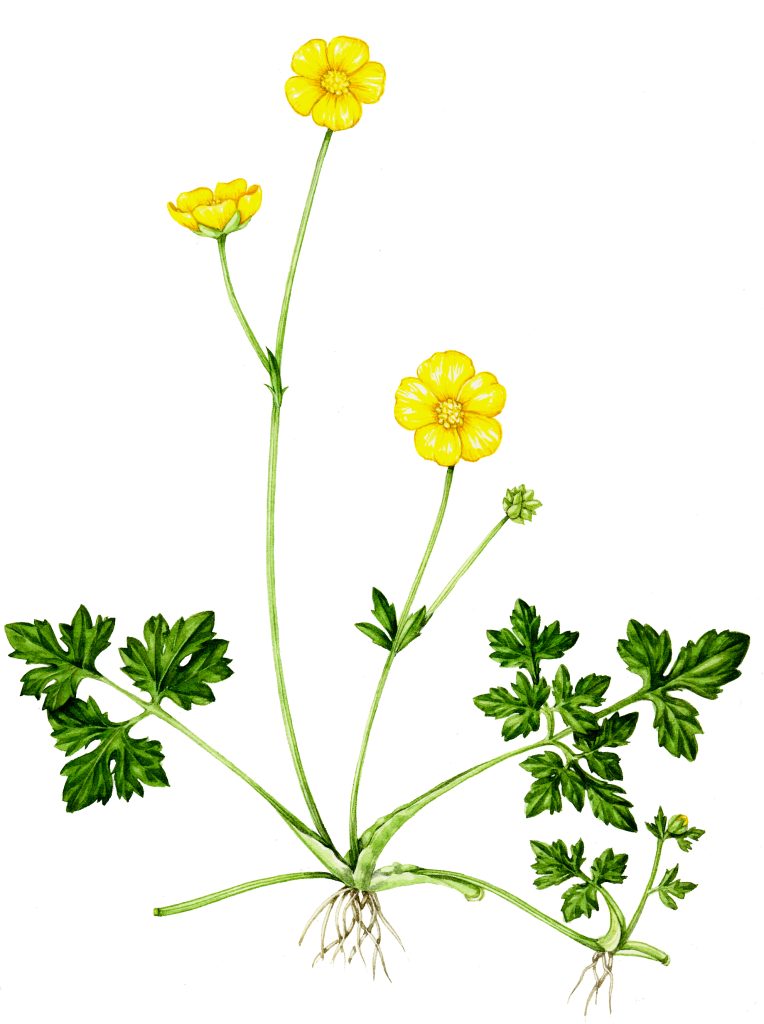
Cruciform
Cruciform flowers have four petals, and are cross-like. They have Actinomorphic symmetry. Many flowers have this form, although often they’re little white numbers that we might overlook.
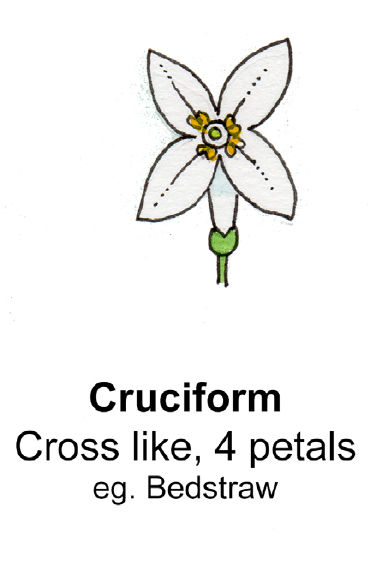
the Bedstraw family all have little white Cruciform flowers.
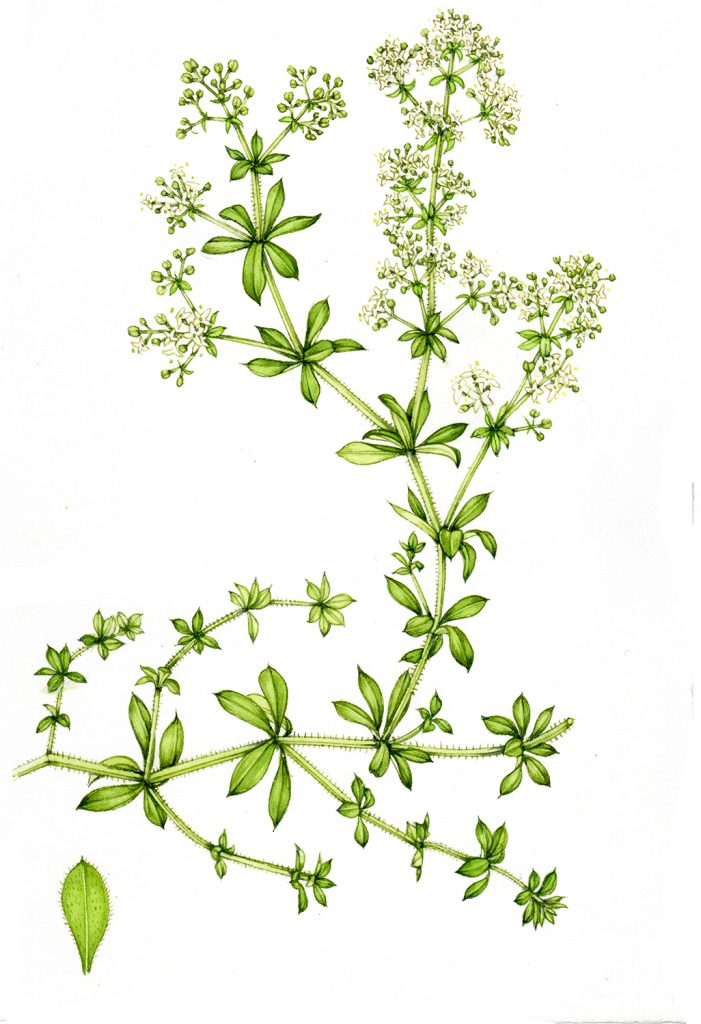
Crateriform
Crateriform flowers are similar in shape to Cyanthiform ones. To be honest, I couldn’t find any online reference which made any difference between the two clear. Perhaps it relates to petal number? Or maybe the terms are inter-changable?
In any case, Crateriform flowers are bowl shaped, rather like a saucer. They show actinomorphic symmetry.
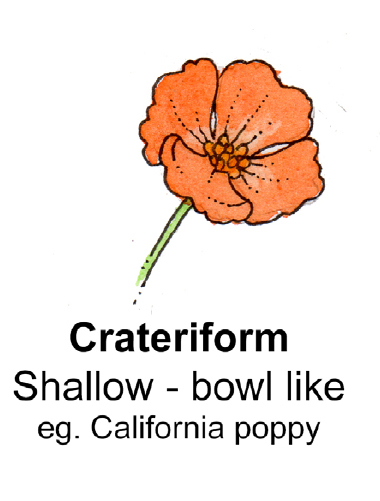
A good example of a Crateriform flower is the poppy. In this case, I’m using the California poppy.
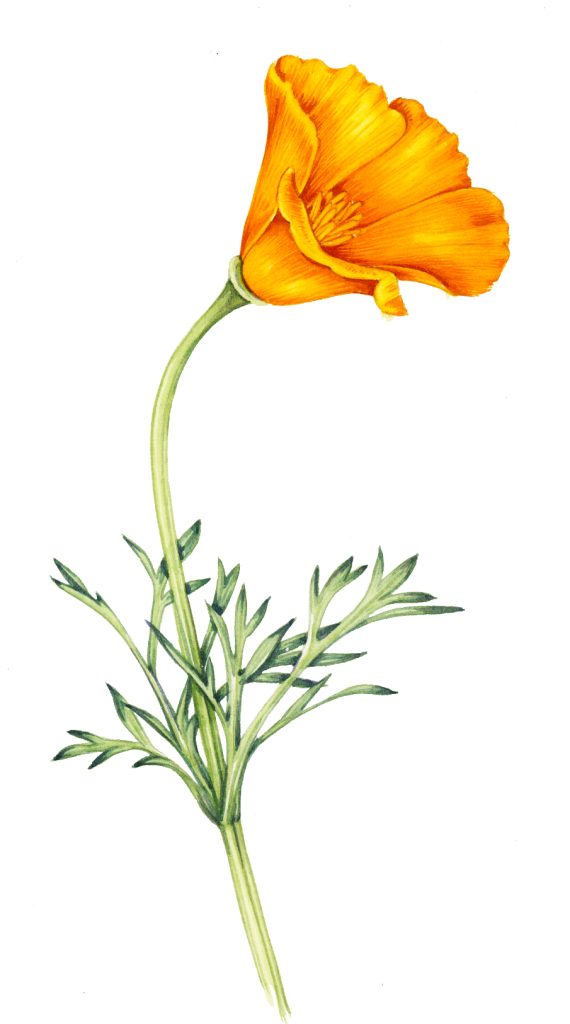
California poppy Eschscholzia californica
Coronate
Coronate flowers are easy, it’s rather a relief. Any flower which is crown-like, and looks like a daffodil is coronate. I can’t think of many flowers that do take on this form, except for the masses of variety of Narcissus and our spring daffs.
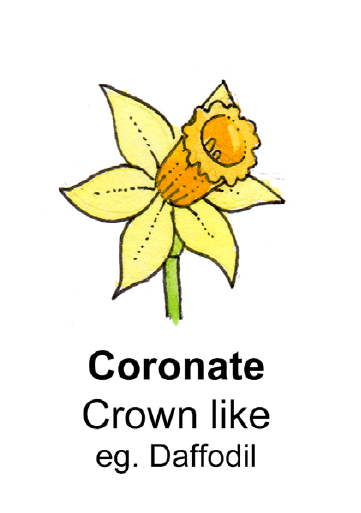
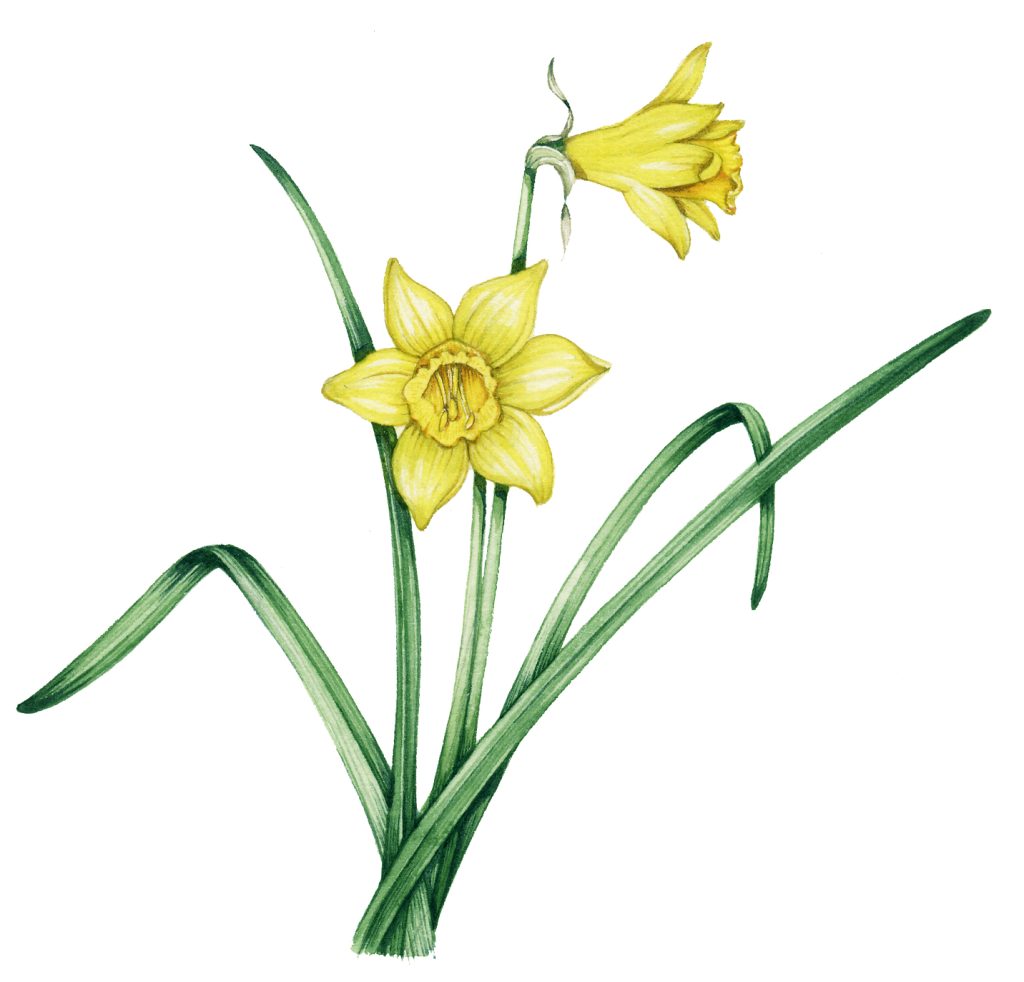
Wild daffodil Narcissus pseudonarcissus
Campanulate
Another easy one. Campanulate means bell-shaped, or bell-like. In fact, all the bell flowers are campanulate. That’s why their family is called the Campanulaceae! Although they have a longer corolla tube or throat, they’re still radially symmetrical. Campanulate flowers are actinomorphic. A good example of a campanulate flower is the harebell
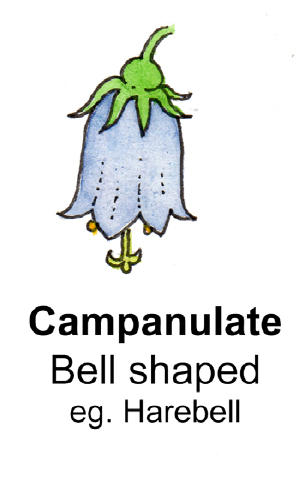
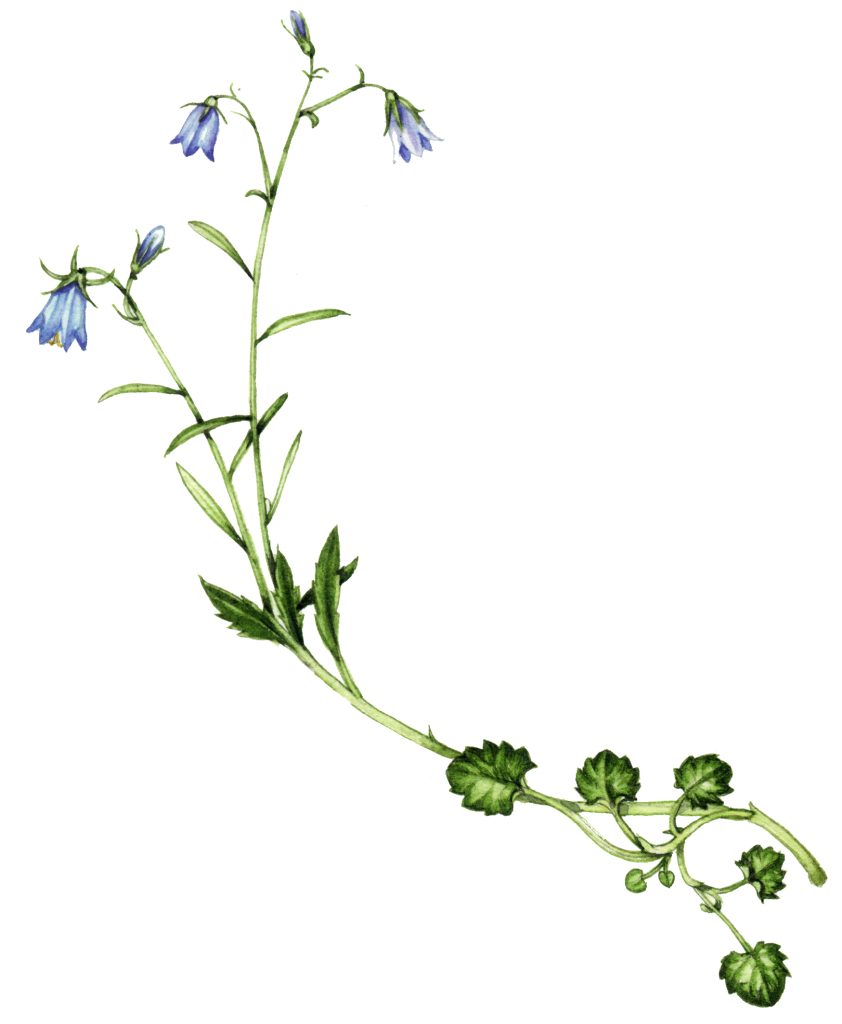
Harebell Campanula rotundifolia
Calceolate
Calceolate flowers are very distinctive, and it’s an uncommon shape. The term translates from the latin as shoe-like, or slipper-like. The only examples of calceolate flowers I can think of are the slipper orchids, none of which I’ve illustrated. Calceolate flowers are bilaterally symmetrical, so they are zygomorphic.
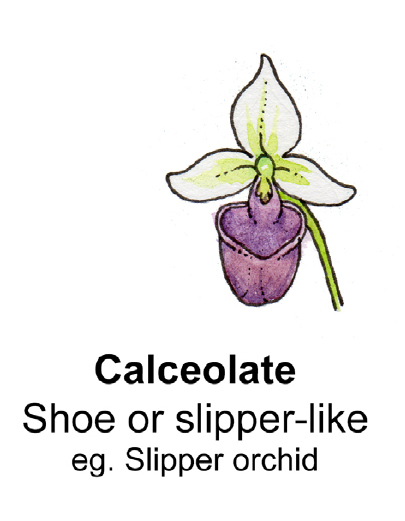
Urceolate
Urceolate flowers are like little urns or vessels, facing down. They have neat petals at the top and a rounded corolla tube. They’re actinomorphic. The heather are a great example of urceolate flowers, especially the bell heather. Another good example is the blueberry, and the Strawberry tree.
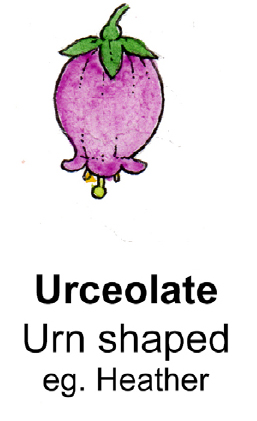
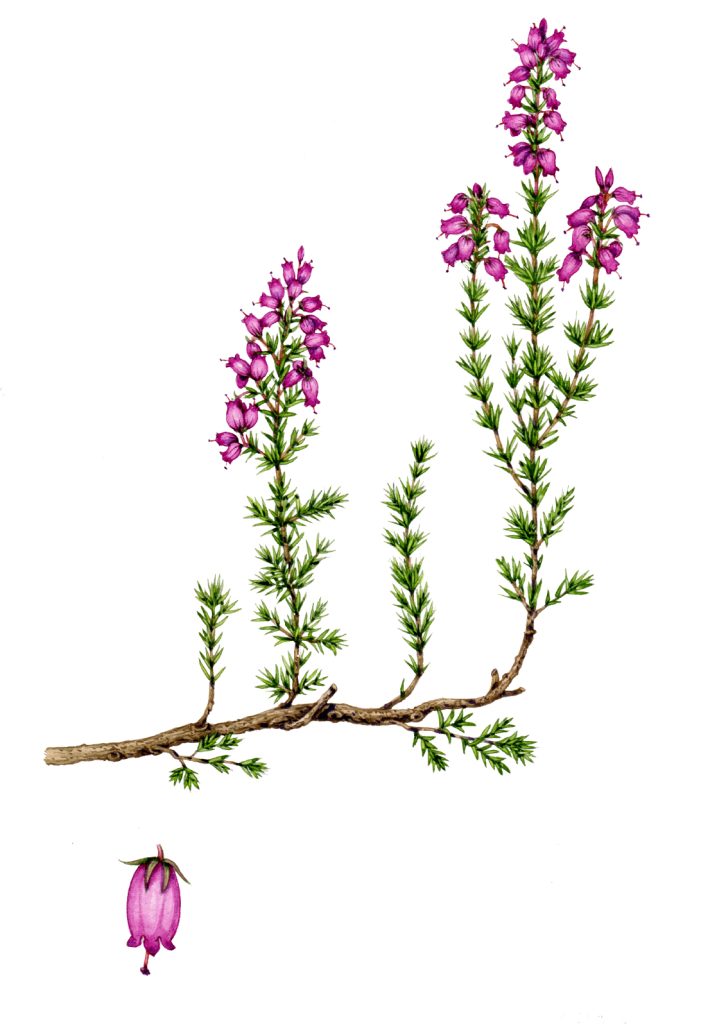
Tubulate
Another self-explanatory term. Tubulate flowers are like little tubes. Their petals don’t splay out at the top of the tube. An example of a tubulate bloom is the Cigar flower. You may not be surprised to hear I’ve not illustrated this species.
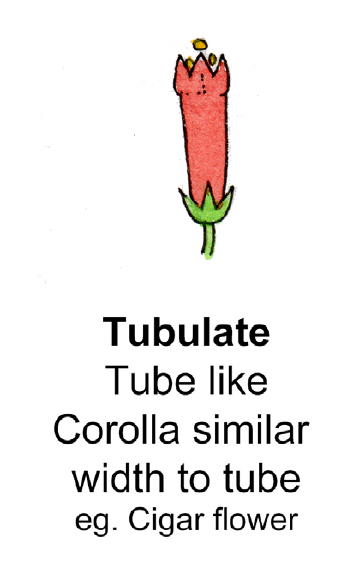
Stellate
Stellate flowers are interesting. They’re star shaped, and radially symmetrical. But the most interesting thing about these actinomorphic blooms is that they consist of tepals, not petals. “What”, I hear you cry “is a tepal!?” Some flowers have sepals and petals which are so similar as to be almost identical. In many flowers, the sepals are very different from the flowers, and mostly green.
With stellate flowers such as lilies, the onion family, and tulips this is not so. The sepals are as brightly coloured as the petals, and are often indistinguishable. You can only tell them apart by seeing where they attach to the centre of the flower. It’s easier to refer to both the sepals and the petals as tepals.


Three cornered leek Allium triquetrum
Salverform
Salverform flowers are shaped like a long tube, and have a flattened disc of petals at the top. There’s not much curving of the petals, so the face of a salverform flower is pretty flat. Plumbago is the example given by many of my references, but I’ve not illustrated that.
Salverform flowers are antinomorphic, posessing radial symmetry.
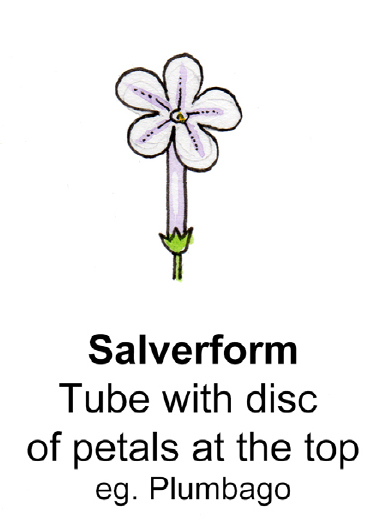
Saccate
Yet another of these flower shapes that I’ve not illustrated. Saccate flowers have their basal coralla area extended and swollen, like a bag. The corolla is fused into a tube. The distinctive bulge is always on the lower side of the flower.
Saccate flowers are zygomorphic, or bilaterally symmetrical. Unfortunately, the only example I could find was the Nemathus. Alas, it;s another plant I haven’t yet illustrated.
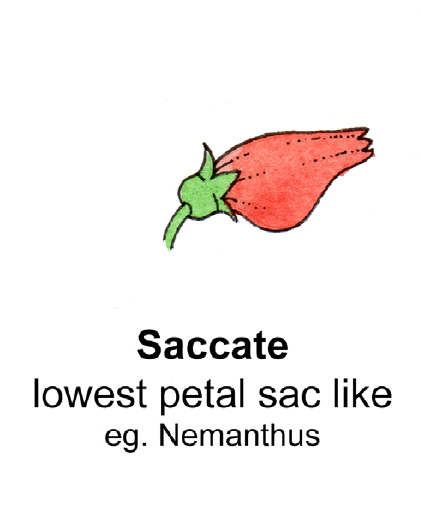
Rotate
Rotate flowers are very common. However, their distinctive characteristic is that the petals aren’t fused together, or if fused it’s a very short tube. No corolla tubes or fusing. Clearly, rotate flowers are actinomorphic. Tomato flowers are rotate.
I’m going to admit to a background level of confusion here. Different sources have different opinions on what species show a rotate form. I’m erring on the side of caution, and leaving the tomato as our sample flower. Unfortunately, it’s another species I’ve not illustrated!
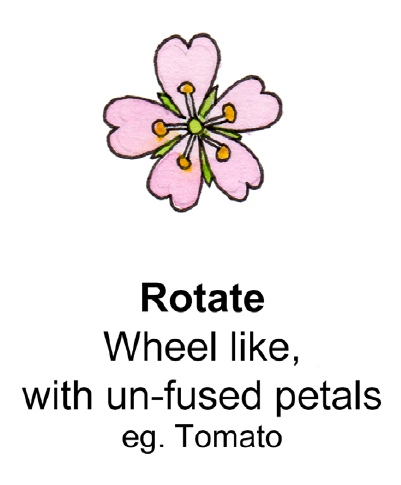
Papilionaceaous
We’re back onto safer ground with a papilionaceous flower form. These are said to resemble butterflies, hence the name. They’re zygomorphic as they show bilateral symmetry. A papilionaceaous flower is easy to spot. All the vetches and the pea family show this flowering shape.
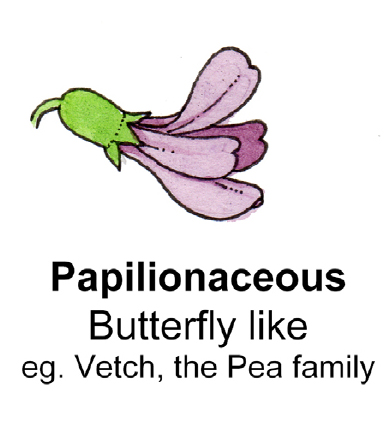
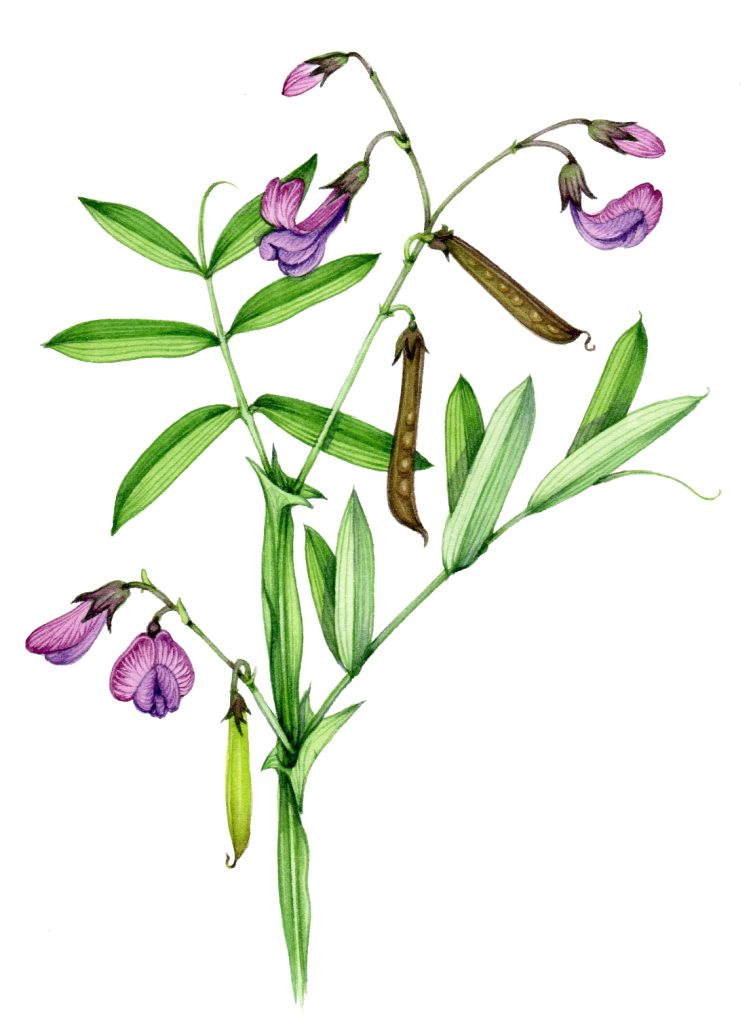
Bitter vetch Lathyrus linifolius
Ligulate
It’s another easy one to explain. A ligule is the strap-like petal found on the ray florets of the Compositae. So a plant having a ligulate flower form is one that resembles a daisy. Outer ray-like petals are the order of the day. Ligulate flowers are actinomorphic.
The clearest example of a ligulate flower form is the daisy.

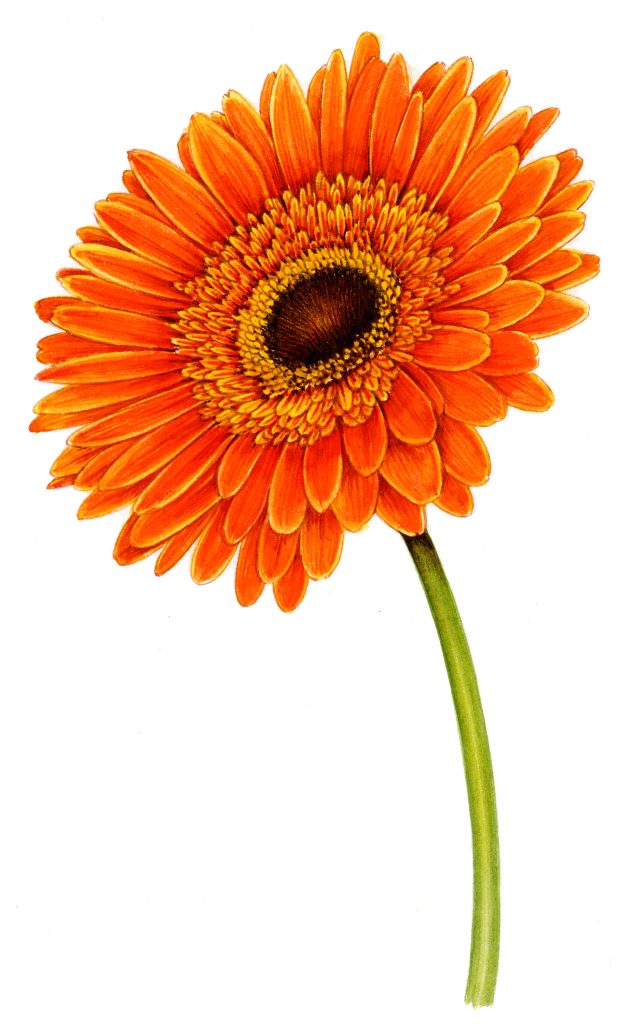
African daisy Gerbera
Labiate and Bilabiate
Labiate flowers have lips, or are lipped. The flowers look like a throat with an upper an lower lip, resembling a mouth They tend to have long, fused corolla tubes with an enlarged lower lip. Labiate flowers show bilateral or zygomorphic symmetry.
Bilabiate flowers have two lips. These are often fused at their bases. All the mint family (Lamiaceae) have bilabiate flowers.
There’s rather a good link if you want to know more about labiate flower form, from Orbis consulting.
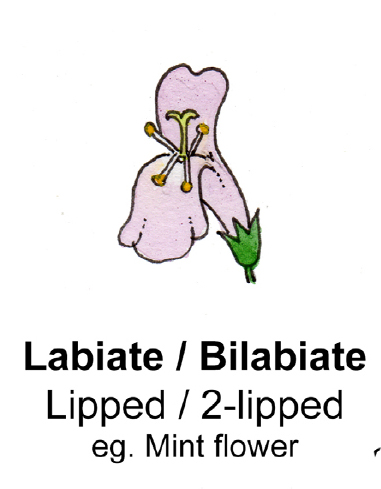
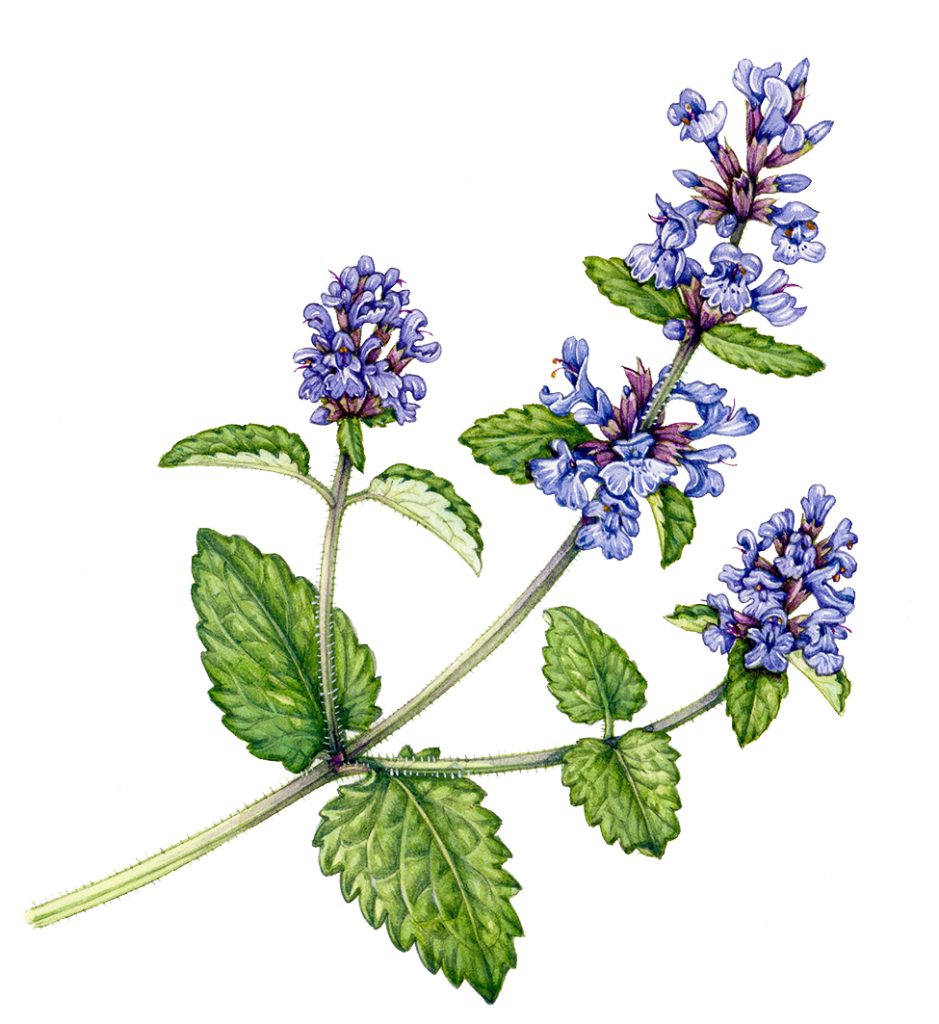
Catnip Nepeta cataria
Galeate
Galeate flowers are hooded, or helmeted. Like the labiate flower forms, they have a clear lower lip. The main distinction is the obvious hood over the top of the flower. This is called a galea. Think of a dead nettle or monkshood (the clue’s in the name!).
Lousewort also have a galeate form.
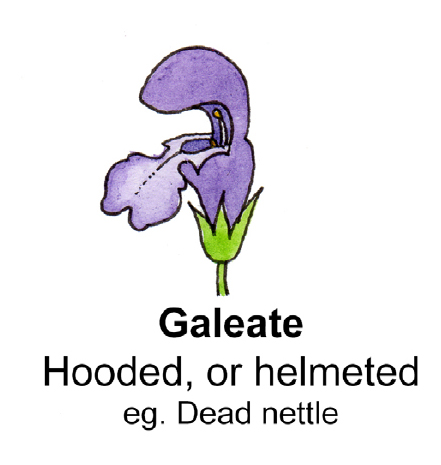
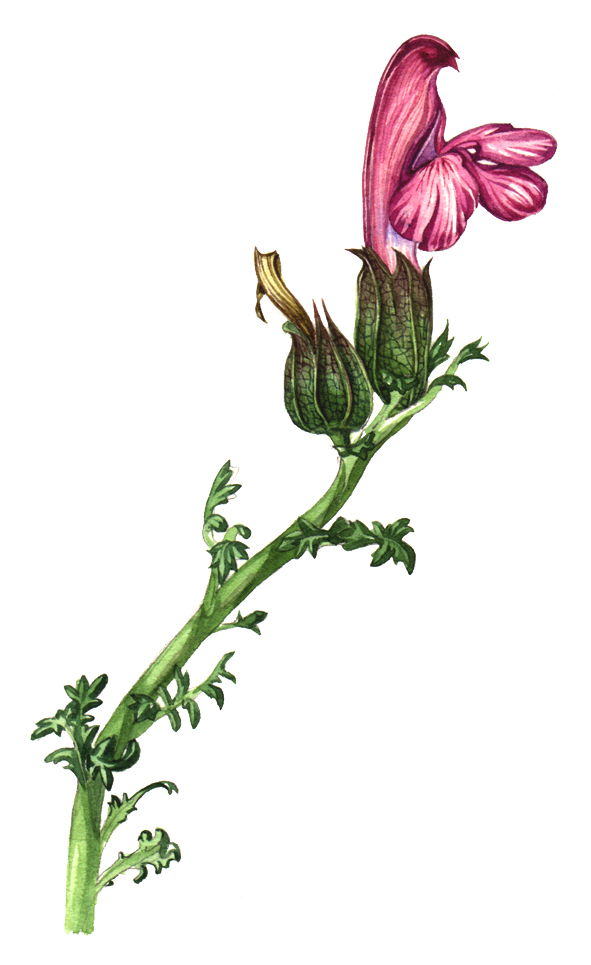
Lousewort Pedicularis sylvatica
In my illustration the hood is less pronounced than it might be.
Funnelform
Another easy one to end with. Funnelform flowers look a whole lot like a funnel. The flower shape widens slowly from the base, into a trumpet or funnel shape. Like many of the other flower shapes, funnelform blooms are actinomorphic.
The most obvious examples of funnelform flowers are the Convulvulus, like the morning glory below.
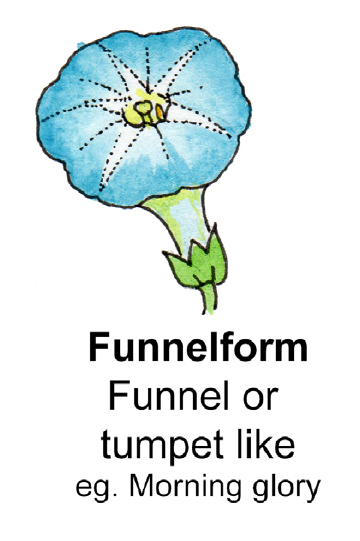
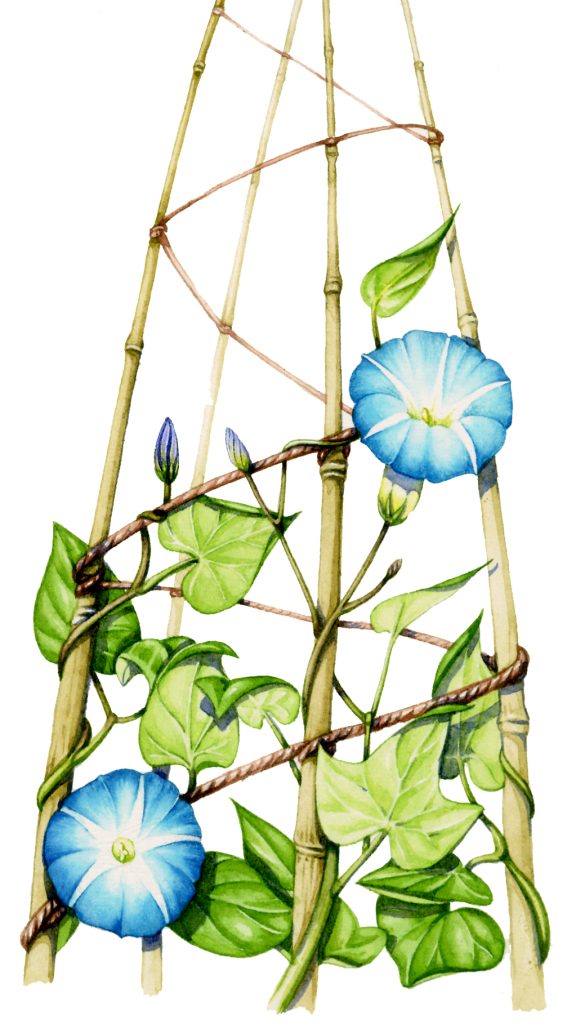
Morning glory Ipomoea purpurea
Flower shapes: An overview and conclusion
Now we’ve gone through each shape one by one, here they all all together on one sheet:
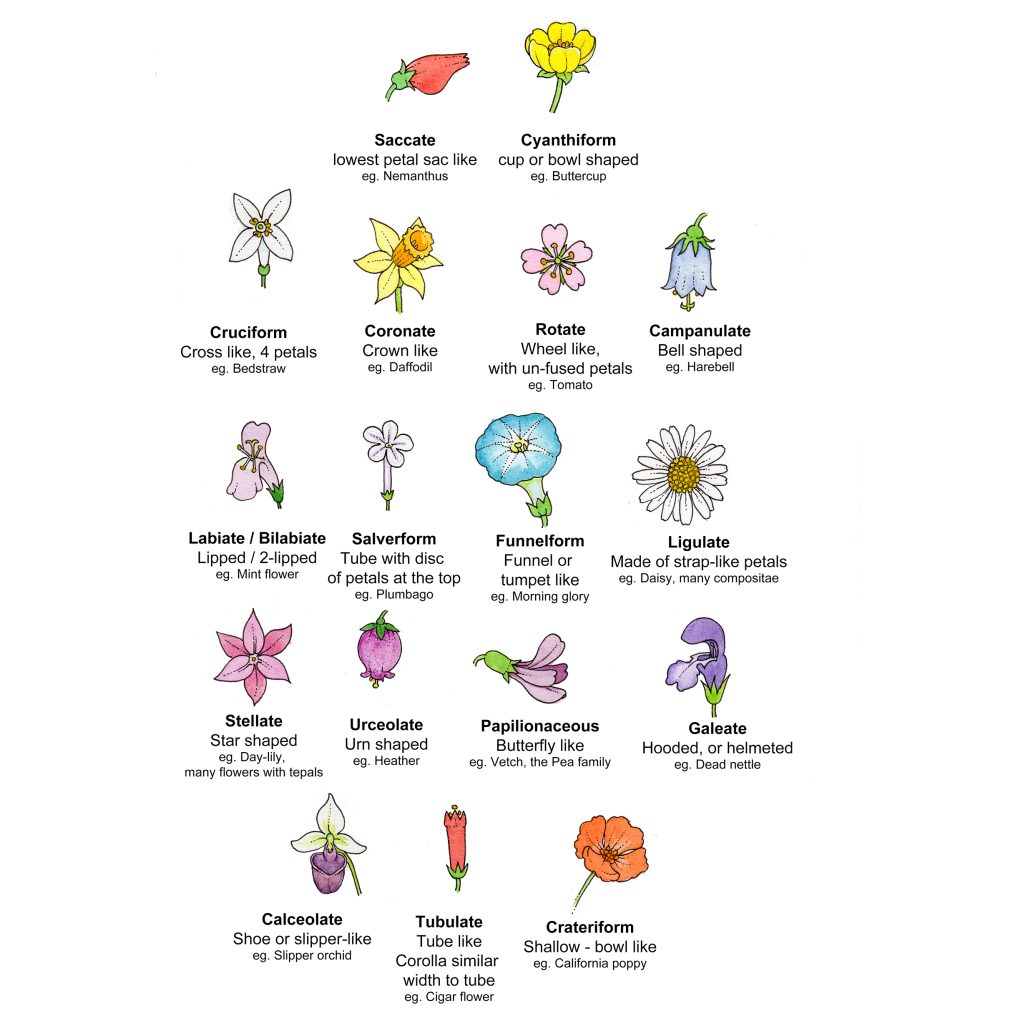
My main references for this blog were The Cambridge Illustrated Glossary of Botanical Terms by Michael Hickey and Clive King, and Kew Plant Glossary by Henk Beentje.
There are loads of websites on this topic, all with slightly different terms. A good one is the Flowers on India site, and the Seed site. It can be useful to have an online dictionary of botanical terms to refer to, the Wikipedia dictionary of botanical terms is pretty exhaustive, and the Florabase glossary is a good resource.
The main thing to bear in mind, as your head spins with the variety of flower shapes, is what it’s all for. The diversity and beauty of these structures comes down to pollination, and attracting pollinators to a flower. As Candace Galan states in the article “Why do Flowers vary? “Nearly all botanists give animal pollinators credit for the vast smorgasbord of flower shapes and sizes observed in nature.” However, as she point out, other environmental factors are also involved, as are a plant’s enemies and the costs of producing these amazing flowers.
For more of my blogs on plant morphology and botanical terms, click the link.


Fabulous LIzzie – very informative and easy to understand! Thank you very much.
I’m so glad you liked it, thankyou!
Beautifully created and explained
Thankyou! Im glad it helps. There’s so much variation and scope when it comes to these terms though, it can be overwhelming! And a lot of the terms are synonyms, just different preferred terms used by different botanists. It’s all about picking away at the language until it becomes totally clear that playing about with botany isn’t that hard at all, and can be fun for absolutely everybody. Thanks for the comment!
Thank you for your clear descriptions and your illustrations are both concise ( the small ones) and
beautiful (your botanical illustrations). I am studying Botany for the first time and your illustrations have confirmed the absolute delight of the Botanical world. Again thank you.
Hello Patricia
I am so happy to hear the my blog was useful. Some people find botanical terminology dull; the more I learn about plants and flowers the more intregued and delighted I feel about the anatomy behind plant life. What a treat to be learning botany – if I could rewind I wonder if I might end up doing a botany instead of a zoology degree…. Thanks for sharing your enthusiasm, and for taking the time to comment. It’s much appreciated.
Yours
Lizzie
This information, especially the beautiful illustrations is extremely helpful. I have been confused about some of the terminology and you have clarified them for me. Your blog in general, is fantastic. Thank you for sharing your knowledge and experience.
Hi Jean
Thanks for this. I always worry a little with botanical nomenclature of shapes, as it does seem to vary quite a lot. So this was me trying to cram the general received wisdom into one place, as much for me to refer to as anything else! So glad it’s useful. And many thanks for your kind comments about my blog!
Yours
Lizzie
Thanks for Sharing this Blog!!!
My pleasure, Heather.x
Love all the information you give. I’d like to use this for homeschool, is it possible to get a bigger resolution of the first handout? The one that shows the symmetry and shapes? It just prints up a little small.
Hi Sophie, of course. Drop me an email on info@lizzieharper.co.uk and I’ll send you a high res image., x
Thank you so much for all the information.
My pleasure
Thanks for sharing this informative article with us on flower shapes.
My absolute pleasure
Lizzie— thank you very much for this beautiful and clear information on flower shapes! I’m leading a Flower Team at a community garden and would love a high resolution photo I could put up in the garden?
My email: gromi1946@gmail.com
With much gratitude, Carol
Hi Carol, Ive just sent over an email. Good luck with the garden!
Thanks for sharing with us about flower shapes terminology . And you can check here flower names in Hindi.
This post is such a fascinating dive into flower shapes and their botanical terminology! 🌺🌸 As someone who’s always been captivated by the beauty of flowers, I love learning about the various shapes and the specific terms used to describe them. It’s incredible how nature has crafted such a diverse range of forms, from the elegant symmetry of radially symmetrical flowers to the intricate patterns of bilaterally symmetrical ones. Thank you for sharing this educational and visually appealing content! Do you have a favorite flower shape or a particular term that caught your attention?
Hi Jerome, isnt the diversity of nature extraordinary? I really like gorse and broom flowers, because of the complicated mechanics of pollination. Its the weight of a bee landing on the base petal that causes the stamens to be pushed down and onto the back if the bee, ensuring it gets covered in pollen. A lighter insect? Not heavy enough to pull the stamens down, so no wasted pollen. I also love the tiny florets of composite flowers, with their deeply satisfying radial symmetry. And Im a sucker for the tubes of morning glory….
This post is a gem! The thoughtful analysis and clear presentation make it a must-read. Much effort was put into ensuring the information is valuable and accessible. Great job.
Many thanks, Eicher
This post is really interesting for me. I love words and their metaphors. It was nice to learn a little more about the plants around us. I hadn’t heard of it before, but it’s great. Maybe your readers will come up with some flowers name ideas.
Hi Sam
Glad you like it, and I like the link to the hindi flower names site.
All the best
Lizzie